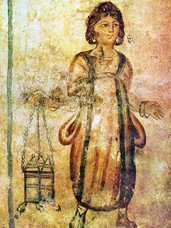Life as a slave
These teacher notes provide information on what it was like to live as a slave. You can download a copy of these teacher notes below.
Download: Life as a slave PDF resource (268 KB)

How is slavery different to being a servant?
A servant is someone who is paid a wage for their work, and who can change jobs whenever they like in search of a better master or more money or another line of work entirely.
A slave is given no wages. They cannot change their owner unless their owner sells them, and they have to do what job their owner tells them to do, whether they want to do it or not.
Possessions
A slave did not own anything. Everything they had belonged to their owner. Some slaves could do additional work and make some money that way, but it did not belong to them. A good owner would allow them to use this money anyway to buy their own freedom and a bad owner would just keep it for themselves.
Roman attitudes to slaves
The Romans preferred a slave who had been born at home and grew up as a slave and therefore knew no other life. They were easier to control than someone who had been born free but later sold into slavery. The Romans often made wide generalisations, such as considering all slaves to be lazy, dishonest, prone to stealing, pretending to be sick and causing damage.
Running away
Slaves running away from their owner was quite common, but this was a big decision for a slave to make. The owner might put up ‘wanted’ posters or employ a professional slave-catcher to find them, and citizens had a legal duty to hand back any slaves to their owner, however badly treated they had been. A runaway slave had to leave their family and friends behind and find somewhere safe where no-one would recognize them, but would spend the rest of their lives afraid of being caught.
An owner would punish a runaway slave that was returned to them. Whipping was the most common way of punishing slaves, but the owners might also make the slave work in chains, be branded by a hot iron or tattooed, or sent to work in the mines. If the owner later sold the slave he had to tell the new owner the slave was a known runaway or otherwise the new owner could demand a refund.
Freedom
It was a well-accepted aspect of Roman life that slaves could be freed (usually after the age of 30) and become a citizen and a more valued member of society. Slaves could buy their own freedom from their owner, or their owner might die and grant them freedom in their will. A freed slave might go into business with their ex-owner. Freedmen and freedwomen made up a large part of Roman society, but people rarely forgot that they had once been slaves.
Freedmen and freedwomen would buy slaves of their own. Would they make good owners, because they had been slaves themselves, or bad owners, because they knew all the tricks slaves got up to?
Jobs
A slave in a poor household would have to do all sorts of different jobs- fetching water and fuel, shopping, cooking, cleaning, making beds, serving at tables, helping their owner get dressed, accompanying them to the baths etc. A slave in a rich household with 10, 20 or 50 slaves was more likely to have just one job to do, such as water-carrier or hairdresser. For some, life in a large household would have meant plenty of work – such as a cook having to prepare the meals for everyone – but for others, such as a hairdresser it meant less work. Some slaves therefore had more free time than others. Some slaves had enough free time to make money for themselves to save up to buy their freedom.
Clothes
There was no special clothing worn by slaves. Slaves that would be seen by guests, like those serving in the dining-room, would wear good quality clothes so the owners could show off their wealth. Favoured slaves might even wear old clothes that used to belong to their owners (the value of clothes went down the more times they were washed, so slaves might wear faded clothes). Other slaves would wear cheaper clothing, but this was still of the same quality as worn by poor free citizens.
Living quarters
Some skilled slaves in large households might be given their own room. Others might have to shared rooms with other slaves, and even share their beds. Many probably slept near where they worked, such as on the floor of the kitchen or over the stables, or in the roof space above rooms. Many probably just slept on mats or mattresses that were brought out when necessary, rather than in a bed. They may have lived their whole lives in this way, and probably never had a private space to call their own.




